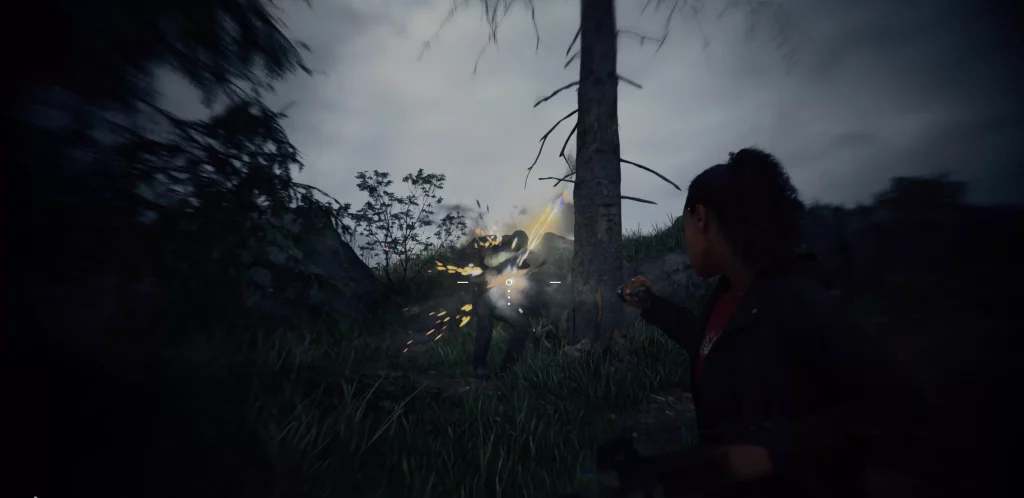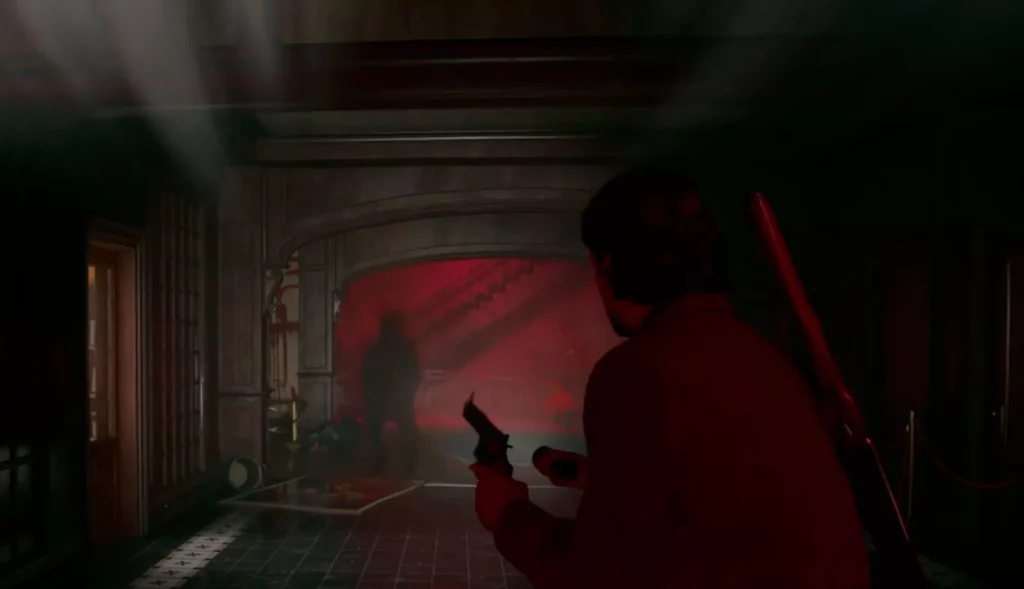“It’s an incredible feeling,” were the words expressed by Sam Lake, the Creative Director at Remedy Entertainment, as he reflected on the anticipation of Alan Wake 2, which is now just a little over a month away from its highly awaited release. This journey has spanned a staggering 13 years for Lake and his team at Remedy Entertainment, marked by numerous false starts, dashed hopes, and creative crossovers, all of which kept the spirit of Alan Wake alive. But it’s only in recent years that the dream of a proper sequel began to materialize. Now, that sequel is nearly upon us, and we’ve had the privilege of playing it.
With this sequel introducing dual protagonists, Alan Wake and Saga Anderson, it was only fitting that players could take control of each character and explore what their gameplay segments had to offer. While there are certain core similarities between Alan and Saga’s gameplay sections, as well as narrative connections, each character boasts a distinct setup.
The demo focused on Saga Anderson’s segment, wherein the FBI agent arrives in the town of Watery, a place stylistically reminiscent of the nearby Bright Falls. Saga is on the trail of the enigmatic Cult of the Tree, seeking clues that may unravel the mysteries before her. However, as Saga delves deeper into the case, she uncovers connections to Bright Falls, Watery, and the Cult that are more profound than she initially grasped. Without revealing too much, the demo masterfully established an intriguing premise, ensuring that Saga’s portions of the game stand as a compelling and integral part of the experience, rather than playing second fiddle to Alan’s storyline.

While Alan Wake 2 retains the third-person shooter perspective of its predecessors, Remedy Entertainment has taken a bold new direction by embracing a survival horror approach. In this iteration, enemies are a less frequent presence as Saga navigates the eerie, waterlogged forests of Watery and its adjacent theme park. When foes do appear, the tension skyrockets to spine-tingling levels. The hallmark light mechanic, where the character must illuminate enemies with a flashlight to render them vulnerable before unleashing a barrage of bullets, remains a core element. However, combat encounters are now less about mowing down hordes of adversaries and more about surviving against one or two formidable threats. While not a direct parallel, there are unmistakable echoes of how both Alan Wake 2 and the Resident Evil series approach their combat encounters.
The third-person mechanics in Alan Wake 2 feel as polished as ever, providing a highly enjoyable gameplay experience. The preview showcased a satisfying blend of exploration, puzzle-solving, and combat, offering a welcome rhythm that allowed players to catch their breath before the unsettling tension resurfaced. Remedy has masterfully crafted the atmosphere of Watery, and the production design is nothing short of exceptional. Facial animations, particularly for characters like Saga and Alan, are stunning, and the world is brimming with intricate details that breathe life into it. Sound design, while minimalistic, amplifies the tension characteristic of survival horror by letting even the slightest noise draw players’ attention, creating an atmosphere that keeps you on edge.
Although not a puzzle game in the traditional sense, Alan Wake 2 introduces challenges that demand more thoughtful consideration than your average game. Players must keenly observe their surroundings and the available clues to progress, yet it never feels like the game is condescending. After all, Saga is a detective, and deductive reasoning is a central aspect of the experience.

Nowhere is this concept more evident than in Saga’s Mind Place, a unique space where she can consult her case board. Here, she uncovers new objectives, strategically places clues, and establishes connections between them. Additionally, she employs her skills as a paranormal interrogator to profile subjects by asking them pertinent questions. It’s a sophisticated portrayal of how Saga deduces conclusions and figures out her next steps, but, more importantly, it grants players an active role in the unfolding narrative. Players are the ones organizing the clues on the board and uncovering connections, rather than passively watching Saga piece it together.
Saga’s segments align more closely with what players might anticipate from a sequel to Alan Wake, both in terms of setting and gameplay. The subtle hints of a broader mystery lurk within every conversation, gameplay is charged with frenetic energy and visceral action, and the world-building is executed with utmost precision. Even without a glimpse of what the Alan Wake sections have in store, these Saga segments provide a tantalizing glimpse into the direction Remedy is heading.
However, the Alan Wake segments shatter preconceived notions of the series and introduce entirely new dynamics. These segments delve deeply into Alan Wake’s role as a writer, allowing him to “rewrite” the world around him to advance. The concept of rewriting the narrative takes shape through two key mechanisms: Alan’s Writers Room and the Light-stealing mechanic.

Alan’s Writers Room mirrors Saga’s Mind Place in that it serves as a hub for him to gather his thoughts regarding the unfolding narrative and deduce his next course of action. However, it introduces a fascinating twist by allowing Alan to transform the environment itself. As he delves deeper into the story that appears to entrap him, Alan gains the ability to shift between different versions of the environment. In the preview, this was exemplified on a hotel floor, where he sought out pathways and clues that would guide him to the next plot development. Echoes within the world also require alignment, and doing so alters the environment surrounding Alan.
In addition to this, Alan wields an Angel Lamp, capable of extracting light from a source and using it to transform specific portions of the environment. For instance, a door may lead to one destination when illuminated by a light source above it, but by using the Angel Lamp to absorb that light and place it elsewhere, the door could lead to an entirely different location. Manipulating light sources in this manner offers a captivating puzzle-solving element, adding depth to the game. However, it’s not a straightforward process; the preview emphasized that Remedy expects players to engage their critical thinking skills consistently.
Alan’s segment leans more toward psychological horror, with clear inspiration drawn from the likes of Kubrick. Nevertheless, it does feature combat encounters. While Saga’s adversaries resemble possessed humans losing chunks of flesh when shot, Alan’s enemies take on a more shadowy, ethereal form. The light-boosting mechanic remains crucial for weakening these foes, but their movements are erratic, and their design exudes an otherworldly quality. Once again, combat is deliberate and suspenseful, enhanced by the signature dodge mechanic, which provides a deeply satisfying gameplay element when executed successfully.

While the Saga segment retained the signature Alan Wake atmosphere, the Alan segment presents a distinct and equally captivating experience. With Remedy’s decision to split the game evenly between the two characters, the developers aimed to strike a delicate balance in gameplay, making it a challenging choice to decide whom to play as next. In this regard, it was challenging to determine which section was more appealing in the preview. Saga’s portion offers that recognizable Alan Wake ambiance, and the shift toward survival horror complements the setting and narrative remarkably. On the other hand, Alan’s segment is so uniquely bizarre that the curiosity to learn more about it becomes irresistible.
Fortunately, Alan Wake 2 offers players the freedom to approach the game as they see fit, and if the preview serves as an indicator, they will find satisfaction regardless of their choice. Sam Lake may feel relief as the finish line draws near, but he also recognizes that the 13-year journey allowed Alan Wake 2 to evolve into the remarkable experience it is today. Technological advancements and creative insights gained from working on titles like Quantum Break and Control have contributed to making Alan Wake 2 a superior game. If this preview is any indication, it could very well be Remedy Entertainment’s finest work to date.
